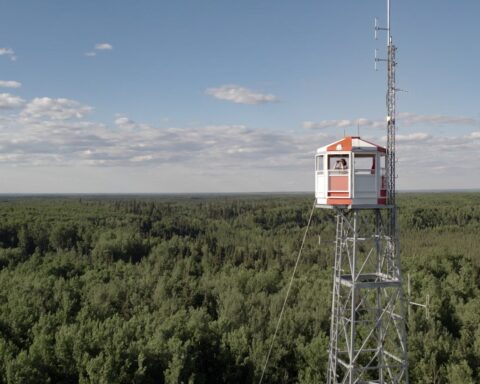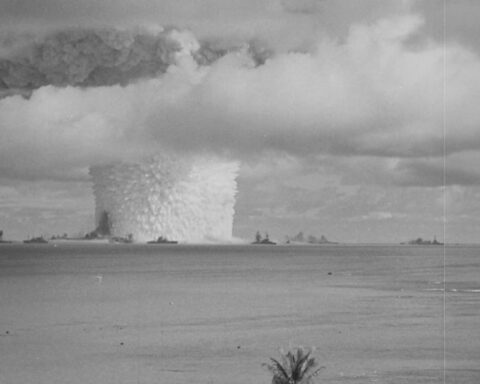We breathe it, we eat it, we drink it. We absorb it, we leak it, we channel it. We are made from it, we subsist on it, we become it. We are healed by it, we are poisoned by it, we die without it. We see it in the clouds, we feel it in the wind, we stand on it in the ground. And yet we never seem to think about it.
It pervades every single aspect of our lives, like nothing else. But when was the last time you actually thought— really thought—about water?
Because if you wanted to ponder one single thing that would touch on as many facets of the human condition as possible, water would be it. It is the simplest of compounds—just two hydrogen atoms bound to one of oxygen—and yet the role of water in our lives today is as multifaceted as it is deceptively straightforward. It is water’s very ubiquity that might make the topic seem so banal, but also which makes it so worthy of serious examination.
Three documentaries have explored this precious commodity in the past year: Blue Gold: World Water Wars (2008), Flow: For the Love Of Water (2008), and Waterlife (2009). Each takes a different tack, but the underlying message is the same: we need to change not just the way we use water, but ultimately, the way we think about water. If we are to stop squandering it, we need to reconfigure water in our minds as scarce and cherished, rather than abundant and disposable.
There is overlap between the three films, but each has a particular focus: Blue Gold illuminates the looming global water crisis and the conflicts its scarcity will provoke; Flow documents the in the developing world; and Waterlife tells the sad story of the toxic tainting of water. All three remind us that everything we do uses water, winds up in the water, and comes back to us through the water.
Blue Gold —the film of the book by Senior Advisor On Water to the President of the United Nations General Assembly Maude Barlow and Director of the Polaris Institute Tony Clarke—lays bare the startling fact that although water seems to be abundant we are actually running out of it. Quickly. A severe global water crisis may only be a half-century away, when we will war over water as we do over oil today.
But unlike oil, we cannot live without water. To open the film, the story of a wayward prospector in Arizona a century ago proves this point with unforgettable clarity: stranded in the desert for a week without water, Pablo Valencia’s lips shrank to nothing, his eyelids cracked, and his eyes bled.
“Whomever of us goes without water for a week cries blood,” the film’s narrator, Malcolm McDowell, grimly observes. With good reason, he asserts that truth that pertains to all “environmental” issues: “This is not a film about saving the environment. This is a film about saving ourselves.”
Water, water everywhere?
Our planet may be “blue,” fully 70% water, but only 3% of that is fresh. Though that is replenished by the earth’s natural hydrology, which draws water from the sea through evaporation and conveniently rains it back to dry land for us, our profligate use has created an unsustainable deficit that nature is incapable of balancing out. Our total water loss may now number 750 billion cubic metres a year, and we may have already reached the halfway point to a global water crisis. We could see a collapse of the planet’s water resources in 50 years.
And when that happens, conflict will follow. Central America, with its unstable political regimes and its teeming waterfalls and rivers, Barlow and Clarke conclude, will find itself ideally situated to become “the Middle East of the future.” Already the Bushes have made inroads to Paraguay to buy up their water, the Texan tycoons symbolically moving to water from oil.
But how can we be running out of something so plentiful so quickly? Blue Gold, largely composed of interviews with academics and activists, explains that the ways in which we waste water are innumerable. Virtually no single human activity can be accomplished without it. Up to seven barrels of water are needed to produce one barrel of oil; a single microchip needs 32 litres; a car drains a staggering 350,000 litres for its production, even before it is ever filled with oil. Our food, too, wastes water to a surreal degree: water is shipped to thirsty California to grow alfalfa to the tune of 70,000 litres per bale, which is then shipped to Japan to feed cattle, costing 5.2 million litres per 750 pound carcass—which is then shipped back to hungry American markets.
“Our life source drips away from us”
Moving water around the planet like this leads to desertification not only where the water is taken from, but also to where it is delivered, as it is not used to replenish natural groundwater. And we have made matters worse by covering the earth with concrete, which robs the ground of the rain that would normally percolate down. Deforestation, which leads to soil erosion and the loss of the vegetation that should keep the soil and its moisture in place, intensifies the problem.
Dams may seem to help by preventing fresh water from reaching the oceans; we built more than 50,000 in the twentieth century. But by preventing nutrients in the rivers from flowing downstream, they starve the growth of downstream ecosystems and lead to more soil erosion and desertification. Moreover, the still water heats up and actually contributes to climate change by releasing greenhouse gases from rotting vegetation.
And to further complicate our water woes, deforestation and climate change (both caused in part by razing forests to graze herds of flatulent cows, whose carcasses are then shipped in greenhouse-gas-contributing planes chugging across the world) will lead to less rainfall in many parts of the world.
All told, we extract, right from under our own feet, “sweetwater” 15 times faster than we allow water to return to it.
“The world water crisis will affect us all,” warns Barlow.
This statement may be difficult to swallow, especially for Canadians, privy to the world’s most abundant supply of fresh water. But already the world’s big engineering and chemical firms, including General Electric, Dow Chemical and Proctor & Gamble, are investing in desalination plants, which will supply fresh water when it is no longer so convenient—for a price.
Though fresh water right now can easily be defended as a communal resource, and thus not available for private ownership, desalinated water will be quite different: the result of an expensive process carried out with sophisticated machinery run by private companies, it will qualify more clearly as a consumer product to be owned and sold rather than a public good.
“They have all seen the writing on the wall: water is the hottest property out there,” says Barlow. “One day,” she predicts, “every single drop of fresh water will be privately owned and controlled.”
Ownership and control
Already water is being funnelled into the hands of a small number of extremely powerful corporations: Thames Water, Suez, Vivendi, and Bechtel have all gained private control of what were public water supplies all over the world. While we in Canada may be used to clean, reliable tap water that costs a fraction of a penny per glass, poor communities visited by the makers of Flow, from Lesotho to India and Bolivia to South Africa have found themselves paying private water cartels very pricey rates. The rates are so expensive, one man in Ghana tells Blue Gold’s filmmakers, that he can literally only afford two toilet flushes a month.
It is easy then to understand why so many continue to drink fetid river water, though it is polluted with raw sewage and factory farm feces, carrying with them diseases like polio, tuberculosis, hepatitis and cholera—and why water-borne diseases kill more children worldwide than malaria, AIDS, or even war itself. “Fetuses and dead dogs” may sometimes float through the river, and the water may literally run red with the blood from slaughterhouses, but for so many millions worldwide there is no other option.
But rather than installing cheap and reliable drinking water infrastructure, the IMF and the World Bank require the privatisation of water supplies in exchange for debt relief. And with privatisation almost invariably come price hikes and a decline in service—which makes sense, if private companies are mandated first and foremost to provide profits for their shareholders.
Pre-pay meters, expensive tokens, and taps that work only intermittently are provided by cartels that rank among the most lucrative companies on the planet. We may have come to think of tap water as so normal that we are not remotely inclined to think of it as a precious luxury—but in much of the world, it is precisely that: a luxury, and one that often has to be reached by several miles of walking. A crowd of South Africans cheering a running tap after waiting five hours in line to see it gush forth reminds us that water is a necessity first and a commodity second. But this universal human right has been transformed into just that: a commodity.
“We cannot fight the world water crisis by just saying, let’s hook up some more people and hope that does it,” says Barlow, speaking in Blue Gold. “We have to challenge the systems that deliberately create winners and losers. We will never, ever solve the world water crisis until we have the courage to talk about the world political and economic system.”
Where there’s a will there’s a way
Though the problems illustrated in Blue Gold and Flow are serious, the solution, as a Russian hydrologist puts it, is very simple: to fight the privatisation of water, make sure there is no market demand.
This means returning to the water conservation techniques we used to employ: harvesting rainwater from our roofs, using less water intensive crops, not wasting water on ornamental gardens and lawns, and digging water catchments, very small wooden dams to create small local pools of water, lauded as the “antidote to desalination” in Blue Gold.
Low-tech solutions can help provide safe drinking water to the world’s poor, such as the UV-light based disinfectant designed in India that costs just $2 per person per year highlighted in Flow.
Margaret Mead’s famous quote, “Never doubt that a small group of thoughtful, committed citizens can change the world. Indeed, it is the only thing that ever has,” may seem clichéd and idealistic, but it is hard to refute.
After privatisation by Bechtel caused rates to skyrocket and quality to plummet in Bolivia, a public uprising exploded, led by a shoemaker who later said they were waging “a fight between a dignified life, a life with joy, or a life with submission, bitterness and sorrow, which isn’t worth living.” They successfully ousted the corporation.
There are other stories of grassroots success. In Uruguay, a constitutional amendment established water as a human right and will prevent privatisation in the future. Closer to home, the townsfolk of Mecosta county in Michigan managed, after years of court cases, to stop Nestle from pumping their groundwater—at a rate of 140 gallons a minute—and carting it away to be sold as bottled water.
But theft and control of fresh water are still big problems worldwide, so to safeguard our water for the future, the makers of Flow appeal to us to join their petition to have the right to water added to the Universal Declaration of Human Rights.
Water for life
Taking a very different approach, and exploring very different issues, is the newest of the three films, Kevin McMahon’s Waterlife.
Where Blue Gold and Flow present clear arguments, offering solutions to what are articulated as indisputable problems—water scarcity, our irresponsible use, and its looming private control—_Waterlife_ explores issues that are far less cut and dried because they incriminate each and every one of us as both culprits and victims: pervasive toxic pollution and irreversible ecological degradation.
Director Kevin McMahon explores these global issues with a study of the Great Lakes, the last great store of fresh water in the world and home to 35 million “lucky people,” as narrator Gord Downie describes us. These lakes are also one of the most heavily industrialized and polluted fresh water systems in the world.
Opening with sunlight dappling through clear blue waters and the smiling, chubby faces of St Lawrence belugas, we learn that a full quarter of the whales suffer from cancer, thought to be linked to the chemical contaminants they carry in their bodies. Though we around the lakes “have plenty to drink in a thirsty world, that water gathers up enough misfortune to kill a whale.” It is that story of misfortune that Waterlife tells, starting with the seemingly pristine waters of Lake Superior, all the way down to the mouth of the St Lawrence.
The predicaments studied by Flow and Blue Gold could be fixed for the most part: dams could be opened, laws changed, constitutions amended, groundwater restored. We can still avert a global crisis.
But Waterlife addresses problems that may be impossible to fix, and which are more the result of misguidance than outright greed. Fittingly, the tone is more sad and resigned than angry and outraged.
Rather than presenting an argument with a string of expert testimonials and a series of statistics, Waterlife weaves a subtle narrative with vignettes and personal stories from around the Great Lakes. As an Anishinaabe medicine woman says, “When you drink of water you are part of that water, as we are all a part of each other—we are all water, all of us, and the water is a uniter, uniting us together.” Where the other two documentaries focus on water’s economic exploitation, Waterlife reminds us that water provides us with an “emotional sustenance that nothing else can provide.”
Heart-breaking interviews with the residents of the notorious Love Canal, panning shots of towering, black industrial slag piles on Lake Huron, and animated explanations of how synthetic pollution mangles our biochemistry are interspersed with slow-motion scenes of children splashing through sun-sparkled sprinklers and gorgeous aerial shots of the shoreline to remind us of water’s primal role in our lives.
Alien invasion
Though the spread of foreign species may not seem like a matter of serious concern, their introduction into the Great Lakes have utterly devastated the region’s natural ecology—and we may never be able to undo this.
Introduced as accidental passengers in ballast water in large trans-continental ships, invasive plants and animals, freed from the predators, competitors and pathogens that would normally control them in their home environment, have run rampant through the Great Lakes and destroyed the fisheries that were already dwindling.
The notorious zebra mussel managed to take over the Great Lakes in just a few years of its introduction in 1996. Their rapid reproduction means they have now crowded out many of the small invertebrates, zooplankton and other animals on the bottom of the food chain—and so are leading to the disappearance of fish. Other invasives like lamprey—ancient, tough, tubular parasites—worsen matters.
And other problems pile up: when nutrients pour in, such as from sewage “discharge,” an ecological cascade is set off, starting with an explosion of algae and duckweed followed by invasive grasses—and the water disappears altogether. The sight of a disgruntled former lakeshore property owner mowing the six-foot high grasses where once could be found fish, turtles and ducks is disquieting, but undeniably hilarious.
There are many moments of humour interspersed into Waterlife’s sad tale: a water treatment engineer drinking the “effluent,” fish being trucked from farm to lake, a self-proclaimed “redneck fishing tournament” down the Mississippi with toothless fishermen catching leaping Asian carp with waiting butterfly nets. Most unforgettable is the sight of a bloated cylinder of “sellable solid”—the compressed feces of thousands of people—being squeezed into a truck to be sold for profit.
Boys will be girls
But there is little humour to be had in the main story told by Waterlife, which begins with the belugas and continues through the pervasive toxic pollution that runs through the Lakes—and through all of us.
The Lakes—and almost every drop of water worldwide, down to the deep sea and up to the Arctic—are stained with the residue of a century of industrial emissions. Pesticides, flame retardants, solvents, petrochemicals and thousands of other synthetic compounds litter the lakes, travel through the foodchain, and wind up in our own bodies. We have a very poor understanding of how they may be affecting us.
Many of them, we do know, behave like hormones. Fish and frogs in the lab and in the wild become “feminised” when exposed to them. Could they be contributing to the global rise in breast and prostate cancers and the decline in sperm counts?
The community of Aamjiwnaang, an Anishinaabe First Nations reserve just outside of Sarnia, may provide a clue: it is completely surrounded by petrochemical factories, and has been exposed to smog and petrochemicals from all sides for many years. And with two girls for every boy, it is statistically almost impossible to say that their children were born with such a skewed sex ratio by chance—all fingers point to the smokestacks that fringe their reserve. Miscarriages, cancers and lung diseases are endemic.
But as sad as their story is, Waterlife reminds us that we are all responsible: Sarnia was the heart of Canada’s petro refining industry. If you have ever driven a car, held a plastic pen, used a computer, or eaten produce grown with pesticides, you have used the products of this industry.
But we are all the victims too: though not at the same levels as the residents of Aamjiwnaang, we all carry the molecules of hundreds of chemicals in our bodies, many absorbed in trace amounts through our drinking water.
Though there is little to offer in the way of solutions to chemical pollution, Waterlife offers one: bring back The Great Law that ruled the habitats of the Great Lakes 350 years ago, before the Europeans arrived. Act in accordance with the needs of seven generations into the future.
Water for thought
“We don’t understand and feel that we are being exposed,” laments an unidentified expert in Waterlife. Without being able to see or smell these microscopic chemical culprits around us or inside us, few people have any appreciation for just how contaminated we have become. And given how little we know about the effects they may be having, and how big an impact they may have, ignorance may well be bliss.
But bliss will not solve anything—only by understanding the scope of the problem can we hope to clean up the mess we have made (and prevent it from getting even worse).
Just as we need to rethink water as something that is precious and a human right, we also need to remember that everything we do will wind up in the water—and ultimately ourselves.
Changing our perspectives and beliefs can be extremely challenging, but this is precisely what documentaries are supposed to do: make us think.
The political, social and environmental issues touched on by these three films are manifold, urgent and complex, and certainly could not be solved in an hour and a half of passive viewing. But before we can even begin to try and solve these gargantuan problems, we need to change forever the way we perceive the ubiquitous, precious and irreplaceable compound that is water. Seeing any of these three films makes it hard to avoid doing just that.











